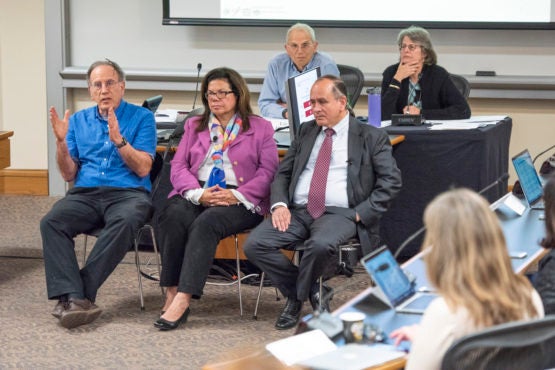Faculty diversity in the spotlight at senate meeting
At Thursday’s meeting the Faculty Senate heard a report on initiatives aimed at increasing faculty diversity and a presentation of the annual report on faculty gains, losses and composition.

Speaking to the senate on Thursday about the composition of the faculty, from left: Robert Weisberg, Yvonne Maldonado and Matt Snipp. (Image credit: L.A. Cicero)
Stanford has made small but steady gains in the number of women faculty, but the proportion of minority faculty remains flat despite many efforts, according to academic leaders who spoke at the Faculty Senate meeting on Thursday.
Against this backdrop, Provost Persis Drell announced an expansion of the Faculty Incentive Fund program as part of the recently announced presidential initiative IDEAL (Inclusion, Diversity, Equity and Access in a Learning Community), which emerged from the long-range planning process. Drell said that beginning this fall, the appointment of a faculty member who brings much-needed diversity – broadly defined – may entitle a Stanford school to a full incremental billet that is fully centrally funded.
Robert Weisberg, special assistant to the provost for faculty recruitment and retention, who administers the faculty incentive fund, explained that previously, a portion of the funding would have to be provided by the school or department. Additional details of the enhanced program will be announced to deans.
Fall 2017 faculty report
Matthew Snipp, senior associate vice provost for faculty development and diversity, gave a brief overview of the 2017 faculty report, which each year outlines gains, losses and overall composition of the faculty.
The report showed that Stanford’s professoriate reached 2,219 in 2017, including 1,569 men and 650 women.
He presented data that showed an increase of women faculty was a continuation of a trend seen in the past decade. In 2017, women composed 29.3 percent of the faculty, compared with 28.3 percent the prior year. In 2007, women made up 24 percent of the faculty; in 1997 it was 18 percent.
“We’ve moved the needle a little bit with respect to gender diversity. We still have a way to go, but we have made some progress,” said Snipp.
In 2017, the Stanford professoriate included 552 members of minority groups, including 159 members of underrepresented minorities and 393 members of Asian descent.
The percentage of members of minority groups – 25 percent – remains unchanged from 2016. Underrepresented minorities made up 7 percent of the faculty in 2017, also unchanged from 2016.
Efforts at enhancing diversity
Yvonne “Bonnie” Maldonado, senior associate dean for faculty development and diversity at the School of Medicine, noted the diversity of the Bay Area population and the need for increasing the diversity of Stanford Medicine’s clinical staff.
“We need a culturally competent clinical workforce to better address the needs of patients who want to see someone who will understand their cultures,” she said.
In her presentation, she touched on some of the School of Medicine’s efforts to address diversity. These include keeping data on faculty hires to promote transparency, creating a new director of culture and inclusion position and establishing the School of Medicine Diversity Cabinet, which is formally charged with recommending to the dean programs and initiatives focused on enhancing diversity and inclusion.
Over the years, the university as a whole has created programs and funded initiatives focused on increasing faculty diversity.
For instance, in addition to the Faculty Incentive Fund, the university supports the Faculty Development Initiative. Housed at the Center for Comparative Studies in Race and Ethnicity, the initiative is designed to recruit outstanding emerging and established scholars and to promote leading-edge scholarship across disciplines to advance race and ethnicity studies in the U.S. and around the world.
The DARE – Diversifying Academia, Recruiting Excellence – Doctoral Fellowship, meanwhile, awards two-year fellowships to advanced doctoral students who want to prepare for academic careers and whose presence will help diversify the professoriate.
